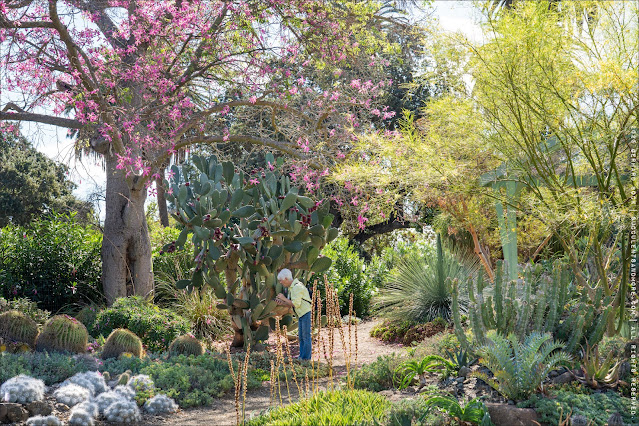This is part 2 of my post about two recent visits to the Ruth Bancroft Garden. Click here to read part 1 if you haven’t already.
Honestly, sharing an experience like this with fellow enthusiasts raises it to another level. I do appreciate alone time and don’t need to constantly be around people, but I highly recommend you join a group like a local cactus and succulent society or a perennial club. Getting together with like-minded peeps, even if it’s only once a month for a couple of hours, can do wonders for your energy, enthusiasm, and creativity. Plus, chances are you’ll learn from others in the process.
 |
| Silk-floss tree (Ceiba speciosa) |
One of the most spectacular sights at the RBG at this time of year is the silk-floss tree (
Ceiba speciosa) blooming in the northeast corner of the garden.
Watch this new video by RBG garden curator Brian Kemble; it includes drone footage showing the tree from above. If you’re not familiar with
Ceiba speciosa, it’s native to the tropical and subtropical forests of South America and grows to 40-60 ft. The trunk is studded with sharp conical prickles that deter wild animals from climbing it. The common name, silk-floss tree, refers to the
fluffy content of the fruit capsules, which used to be used as pillow stuffing and the like.
 |
| The flowers from the silk-floss tree blanket everything underneath — as Brian says in his video, it’s a nice problem to have |
 |
| Close-up of Ceiba speciosa flower |
 |
| This Agave nickelsiae might be the most beautiful specimen of its kind I’ve ever seen. Kyle wasn’t the only one photographing it... |
 |
| ...I was, too (obviously) |
 |
| Agave victoriae-reginae is a close relative of Agave nickelsiae. And just like the Agave nickelsiae in the photos above, this specimen of Agave victoriae-reginae is about as perfect as they come. |
 |
| Agave victoriae-reginae |
 |
| More Mammillaria geminispina backlit in the early afternoon light |
 |
| One of the newer beds |
 |
| Trichocereus pasacana |
 |
| Lobivia ferox |
 |
| ×Mangave ‘Tooth Fairy’ |
 |
| ×Mangave ‘Tooth Fairy’ |
 |
| Yucca and eucalyptus |
 |
| Several Boophone disticha, a favorite South African bulb with its signature fan of leaves |
 |
| ‘tis the season: South African bulbs coming up. Always a welcome sight. |
 |
| Agave franzosinii |
 |
| Agave franzosinii |
 |
| Agave franzosinii as you walk into the nursery |
I’ll have a separate post about the most exciting thing happening at the RBG right now: the creation of a large-scale crevice garden! Crevice gardens are a mainstay in the rock gardening/alpine plant community, but their use for succulents is still relatively novel. The RBG, under the guidance of garden director Walker Young, is doing pioneering work. Look for a post soon. Here’s a teaser:
 |
| RBG crevice garden in the making |
© Gerhard Bock, 2025. All rights reserved. To receive all new posts by email, please subscribe here.






























For some reason, I am not crazy about the crevice garden form. But I do love the Ruth Bancroft Garden. BTW, I have a copy of "The Bold Garden" signed by Ruth Bancroft in 2016, the year before she died, that I would like to sell. Boyce Thompson Arboretum areas (especially the pollinator garden) have been devastated by the recent storms and flooding. I want to donate the money to them. I am hoping to get $200. If you can mention this sale around to lovers of RBG, I would appreciate it. If you don't want this posted here, I understand if you delete this post.
ReplyDeleteNow I'm dying to go back for a visit. Agave franzosinii is stunning, the farina kills me! Oh, to have room for 7' wide agaves. I'm glad you showed that newer bed, I like the way the rock is helping form the area. I've got some spots of awkward youngin's right now, and it's good to remember how magical they get when they grow up. The Mammillaria geminispina are everything.
ReplyDelete